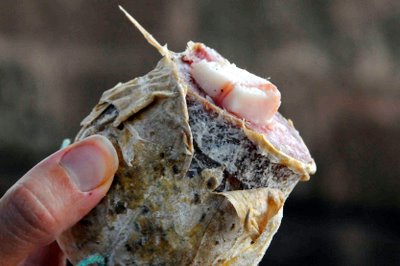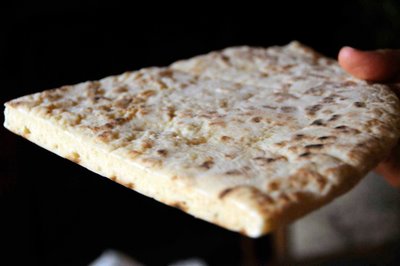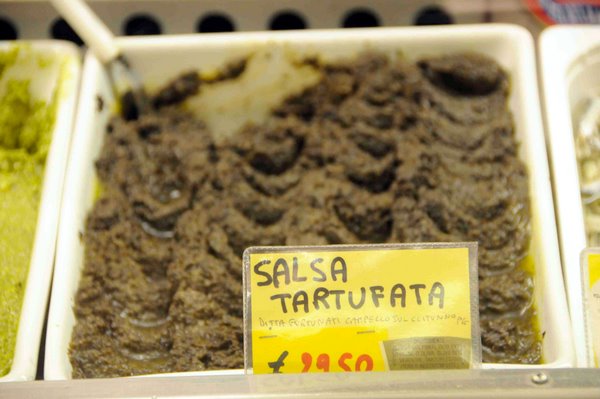I wanted to learn more about Umbria’s traditional foods, especially that strange Norcian mortadella with the chunk of mystery meat inside. When I found the store, Il Parma Delizie Alimentari, with a large man carving meat behind the counter, I knew I  had the right place.
had the right place.
Armando is an experienced purveyor of fine foods, and when I asked him about Umbria’s most important culinary ingredients, he enthusiastically explained. He told me that Pecorino is Umbria’s most important cheese. There are three basic ways of aging Pecorino (I’d only eaten the hard version commonly found in the United States). The freshest is actually soft. It is usually aged 3 months and has a very light texture. The next Pecorino is aged 6-9 months, and it still retains the creaminess, but its sharp flavors are more pronounced (this is my favorite). The final type is aged at least one year, it is very hard and very sharp. The flavor of this cheese is so strong that it might knock you off your feet. Unless you’re a formaggio veteran, you might want to incorporate this cheese in a pasta dish (speaking of which, I have found very few types of pasta or pasta dishes that are unique to Umbria).
 When I asked Armando about the mortadella from Norcia, he said that the piece of meat in the center was lard. Do they put it in to keep the salami moist, I asked? He responded, No, they just put it in because they want to. It serves no purpose. Well, that’s what you get when you ask too many questions.
When I asked Armando about the mortadella from Norcia, he said that the piece of meat in the center was lard. Do they put it in to keep the salami moist, I asked? He responded, No, they just put it in because they want to. It serves no purpose. Well, that’s what you get when you ask too many questions.
Umbria has a traditional bread called torta di testo, which is a flat, almost pita-like bread that has very little salt. Kristin and I made sandwiches on it with Umbrian prosciutto, which is made extra salty to pair well with the local, salt-less breads. The regions around Umbria, such as Tuscany, make their bread without salt. This ancient tradition originated in a protest against the pope. I’m not certain on the century, but the church once controlled the tax and sale of salt. The Italian people became fed up with the pope at the time, and they boycotted salt. The ramifications can still be tasted today.
 Armando finished his lesson by talking about Norcia’s famous truffles. White truffles can be found in the northern areas of Umbria, but the Norcian black truffle receives the most praise. It is made into a spread or sauce called salsa di tartufo, and you can’t beat it when spread on a sandwich. I’ve tried using it on pasta, but I find that the flavors are masked. On a sandwich of fontina and prosciutto on torta di testo, it’s divine.
Armando finished his lesson by talking about Norcia’s famous truffles. White truffles can be found in the northern areas of Umbria, but the Norcian black truffle receives the most praise. It is made into a spread or sauce called salsa di tartufo, and you can’t beat it when spread on a sandwich. I’ve tried using it on pasta, but I find that the flavors are masked. On a sandwich of fontina and prosciutto on torta di testo, it’s divine.
Today I’m heading off to Florence. It looks like rain. We’ll see.


Comments